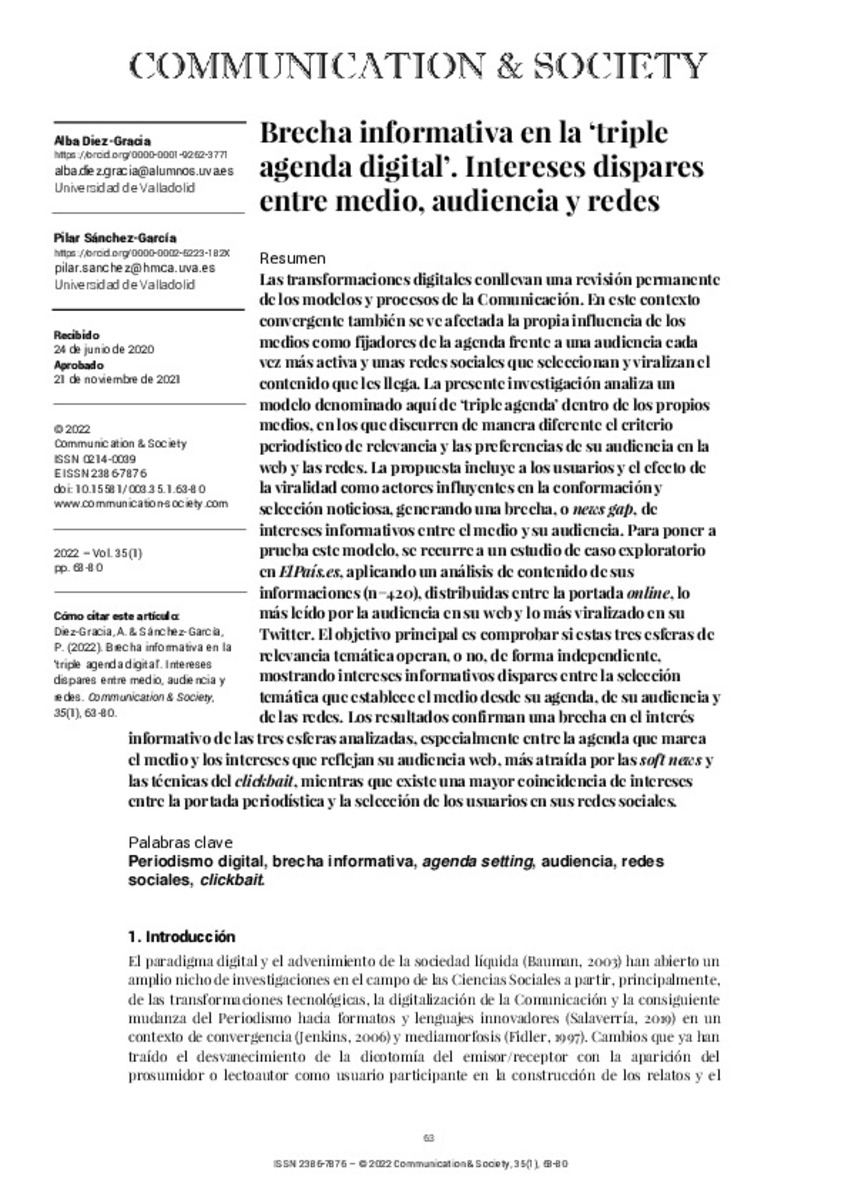Full metadata record
| DC Field | Value | Language |
|---|---|---|
| dc.creator | Diez-Gracia, A. (Alba) | - |
| dc.creator | Sánchez-García, P. (Pilar) | - |
| dc.date.accessioned | 2022-01-10 | - |
| dc.date.accessioned | 2022-03-07T08:11:51Z | - |
| dc.date.available | 2022-03-07T08:11:51Z | - |
| dc.date.issued | 2022 | - |
| dc.identifier.citation | Diez-Gracia, A. (Alba); Sánchez-García, P. (Pilar). "The news gap in the «triple digital agenda»: The different interests of media, audience and networks". Communication & Society. 35 (1), 2022, 63 - 80 | es |
| dc.identifier.issn | 2386-7876 | - |
| dc.identifier.uri | https://hdl.handle.net/10171/63016 | - |
| dc.description.abstract | Digital transformations entail continually reviewing the various Communication models and processes. The influence of the media themselves as agenda setters for an ever more active audience and social networks that select and make certain content they receive viral are also affected by such a convergent context. This current research analyses a model called here the ‘triple agenda’ within the media themselves, in which the journalistic criterion of relevance and their audience’s preferences in the web and the networks travel along different paths. The proposal includes the users and the viral effect as influencing agents in the shape and selection of news, generating a <em>news gap</em> of interests between the media and their audiences. In order to test this model, we study an exploratory case in <em>ElPaís.es</em>, applying a content analysis to the information (n=420) distributed among the online front page, what is most read by the audience in its webpage, and the most viral in its Twitter account. The main objective is to check whether or not these three spheres of relevance operate independently, showing different informative interests f rom the thematic selection that the medium establishes f rom its agenda, its audience and its social networks. The results confirm that there is a gap in the informative interests of the three spheres analysed, especially between the agenda marked by the medium and the interests that are reflected in their web audience, which is more attracted to soft news and the clickbait technique; while there is a greater coincidence of interests between the newspaper’s front page and the users’ selection in their social networks. | en_US |
| dc.description.abstract | Las transformaciones digitales conllevan una revisión permanente de los modelos y procesos de la Comunicación. En este contexto convergente también se ve afectada la propia influencia de los medios como fijadores de la agenda frente a una audiencia cada vez más activa y unas redes sociales que seleccionan y viralizan el contenido que les llega. La presente investigación analiza un modelo denominado aquí de ‘triple agenda’ dentro de los propios medios, en los que discurren de manera diferente el criterio periodístico de relevancia y las preferencias de su audiencia en la web y las redes. La propuesta incluye a los usuarios y el efecto de la viralidad como actores influyentes en la conformación y selección noticiosa, generando una brecha, o <em>news gap</em>, de intereses informativos entre el medio y su audiencia. Para poner a prueba este modelo, se recurre a un estudio de caso exploratorio en <em>ElPaís.es</em>, aplicando un análisis de contenido de sus informaciones (n=420), distribuidas entre la portada <em>online</em>, lo más leído por la audiencia en su web y lo más viralizado en su Twitter. El objetivo principal es comprobar si estas tres esferas de relevancia temática operan, o no, de forma independiente, mostrando intereses informativos dispares entre la selección temática que establece el medio desde su agenda, de su audiencia y de las redes. Los resultados confirman una brecha en el interés informativo de las tres esferas analizadas, especialmente entre la agenda que marca el medio y los intereses que reflejan su audiencia web, más atraída por las <em>soft news</em> y las técnicas del <em>clickbait</em>, mientras que existe una mayor coincidencia de intereses entre la portada periodística y la selección de los usuarios en sus redes sociales. | es_ES |
| dc.language.iso | eng | - |
| dc.publisher | Servicio de Publicaciones de la Universidad de Navarra | es_ES |
| dc.rights | info:eu-repo/semantics/openAccess | es_ES |
| dc.subject | Periodismo digital | - |
| dc.subject | brecha informativa | - |
| dc.subject | agenda setting | - |
| dc.subject | audiencia | - |
| dc.subject | redes sociales | - |
| dc.subject | clickbait | - |
| dc.title | The news gap in the «triple digital agenda»: The different interests of media, audience and networks | en_US |
| dc.type | info:eu-repo/semantics/article | es_ES |
| dc.identifier.doi | 10.15581/003.35.1.63-80 | - |
| dadun.citation.endingPage | 80 | - |
| dadun.citation.number | 1 | - |
| dadun.citation.publicationName | Communication & Society | - |
| dadun.citation.startingPage | 63 | - |
| dadun.citation.volume | 35 | - |
Statistics and impact
Items in Dadun are protected by copyright, with all rights reserved, unless otherwise indicated.







